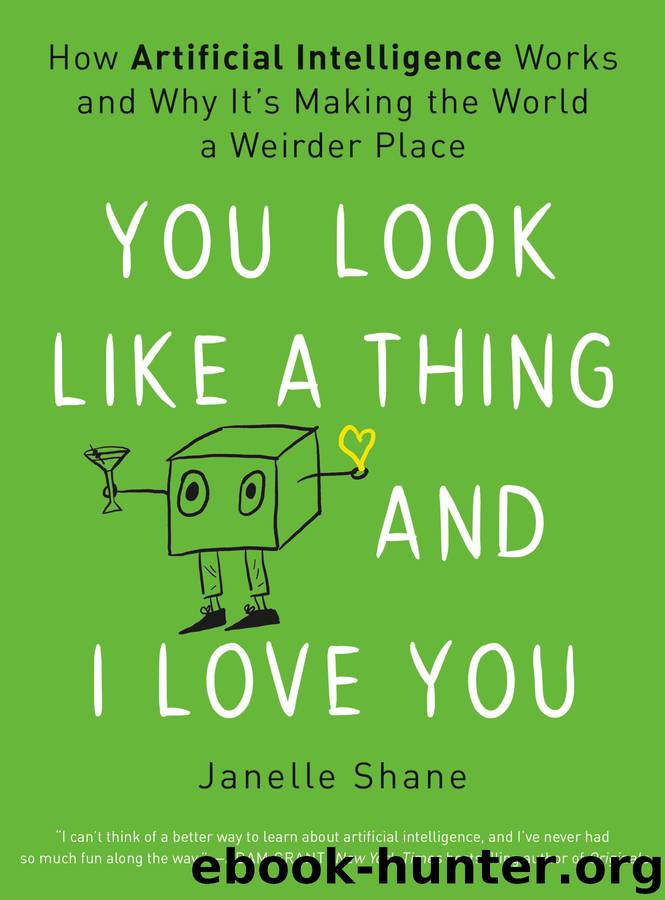You Look Like a Thing and I Love You by Janelle Shane

Author:Janelle Shane
Language: eng
Format: epub, azw3, pdf
Publisher: Little, Brown and Company
Published: 2019-11-04T16:00:00+00:00
THERE ARE FOUR GIRAFFES
There are a lot of interesting data-related quirks that crop up in Visual Chatbot, an AI that was trained to answer questions about images. The researchers who made the bot trained it on a crowdsourced dataset of questions and answers relating to a set of pictures. As we know now, bias in the dataset can skew the AI’s responses, so the programmers set up their training data collection to avoid some known biases. One bias they set out to avoid was visual priming—that is, humans asking questions about an image tend to ask questions to which the answer is yes. Humans very rarely ask “Do you see a tiger?” about an image in which there are no tigers. As a result, an AI trained on that data would learn that the answer to most questions is yes. In one case, an algorithm trained on a biased dataset found that answering yes to any question that begins with “Do you see a…” would result in 87 percent accuracy. If this sounds familiar, remember the class imbalance problem from chapter 3—a big batch of mostly terrible sandwiches resulted in an AI that had concluded the answer was Humans Hate All Sandwiches.
So to avoid visual priming, when they collected their crowdsourced set of questions, the programmers hid the image from the humans asking the question. By forcing the humans to ask generic yes-or-no questions that could apply to any image, they managed to achieve a rough balance between yes answers and no answers in the dataset.14 But even this wasn’t enough to eliminate problems.
One of the most entertaining quirks of the dataset is that no matter the content of the picture, if you ask Visual Chatbot how many giraffes there are, it will almost always answer that there is at least one. It may be doing relatively well with a picture of people in a meeting, or surfers on a wave, up to the point where it’s asked about the number of giraffes. Then, pretty much no matter what, Visual Chatbot will report that the image contains one giraffe, or maybe four, or even “too many to count.”
The source of the problem? Humans who asked questions during dataset collection rarely asked the question “How many giraffes are there?” when the answer was zero. Why would they? In normal conversation people don’t start quizzing each other about the number of giraffes when they both know there aren’t any. In this way, Visual Chatbot was prepared for normal human conversation, bounded by the rules of politeness, but it wasn’t prepared for weird humans who ask about random giraffes.
As a result of the AIs’ training on normal conversations between normal humans, they’re completely unprepared for other forms of weirdness as well. Show Visual Chatbot a blue apple, and it will answer the question “What color is the apple?” with “red” or “yellow” or some normal apple color. Rather than learning to recognize the color of the object, a difficult job, Visual Chatbot has learned that the answer to “What color is the apple?” is almost always “red.
Download
You Look Like a Thing and I Love You by Janelle Shane.azw3
You Look Like a Thing and I Love You by Janelle Shane.pdf
This site does not store any files on its server. We only index and link to content provided by other sites. Please contact the content providers to delete copyright contents if any and email us, we'll remove relevant links or contents immediately.
| Computer Vision & Pattern Recognition | Expert Systems |
| Intelligence & Semantics | Machine Theory |
| Natural Language Processing | Neural Networks |
Algorithms of the Intelligent Web by Haralambos Marmanis;Dmitry Babenko(9832)
Test-Driven Development with Java by Alan Mellor(7648)
Data Augmentation with Python by Duc Haba(7536)
Principles of Data Fabric by Sonia Mezzetta(7309)
Learn Blender Simulations the Right Way by Stephen Pearson(7228)
Microservices with Spring Boot 3 and Spring Cloud by Magnus Larsson(7060)
RPA Solution Architect's Handbook by Sachin Sahgal(6454)
Jquery UI in Action : Master the concepts Of Jquery UI: A Step By Step Approach by ANMOL GOYAL(6447)
The Infinite Retina by Robert Scoble Irena Cronin(6163)
Hadoop in Practice by Alex Holmes(6135)
Big Data Analysis with Python by Ivan Marin(5882)
Life 3.0: Being Human in the Age of Artificial Intelligence by Tegmark Max(5474)
Pretrain Vision and Large Language Models in Python by Emily Webber(4840)
Infrastructure as Code for Beginners by Russ McKendrick(4619)
WordPress Plugin Development Cookbook by Yannick Lefebvre(4339)
Functional Programming in JavaScript by Mantyla Dan(4216)
The Age of Surveillance Capitalism by Shoshana Zuboff(4209)
Embracing Microservices Design by Ovais Mehboob Ahmed Khan Nabil Siddiqui and Timothy Oleson(4112)
Applied Machine Learning for Healthcare and Life Sciences Using AWS by Ujjwal Ratan(4089)
